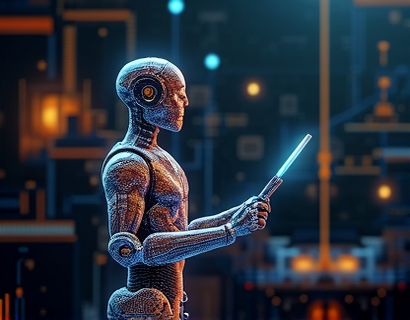Exploring the World of Robotics: A Safe and Educational Journey
Robotics is an exciting field that combines engineering, computer science, and technology to create machines capable of performing tasks autonomously or semi-autonomously. As technology continues to advance, the importance of understanding robotics grows, making it essential for learners of all ages to engage with this fascinating subject. This article aims to provide a comprehensive overview of robotics, ensuring that the content is safe and educational for children and students while also appealing to enthusiasts and professionals.
What is Robotics?
Robotics is the branch of technology that deals with the design, construction, operation, and application of robots. Robots are programmable machines that can carry out a series of actions automatically. They can be used in various industries, including manufacturing, healthcare, education, and entertainment. The field of robotics encompasses several disciplines, including mechanical engineering, electrical engineering, computer science, and artificial intelligence.
The Importance of Robotics Education
Understanding robotics is crucial in today’s technology-driven world. As automation becomes more prevalent, knowledge of robotics can open up numerous career opportunities. Educational programs that focus on robotics can help students develop critical thinking, problem-solving, and teamwork skills. Moreover, engaging with robotics can inspire creativity and innovation, encouraging students to explore new ideas and technologies.
Benefits of Learning Robotics
- Enhances Problem-Solving Skills: Robotics challenges students to think critically and solve complex problems, fostering analytical skills.
- Encourages Teamwork: Many robotics projects require collaboration, teaching students the value of working together to achieve a common goal.
- Promotes Creativity: Designing and building robots allows students to express their creativity and explore innovative solutions.
- Prepares for Future Careers: As industries increasingly rely on automation, knowledge of robotics can lead to various career paths in engineering, technology, and research.
Child Safety Features in Robotics Education
When introducing robotics to children, safety is a top priority. Educational programs and platforms must ensure that content is age-appropriate and that activities are designed with child safety in mind. Here are some essential safety features to consider:
Age-Appropriate Content
Content should be tailored to different age groups, ensuring that younger children engage with materials that are easy to understand and safe to use. This includes using simple language, clear instructions, and visual aids to enhance comprehension.
Supervised Learning Environments
Hands-on robotics activities should be conducted in supervised environments, where educators or parents can guide children and ensure safe practices. This supervision helps prevent accidents and encourages safe exploration of robotics.
Safe Materials and Tools
When building robots, it is essential to use safe materials and tools. Educational kits designed for children should include non-toxic components and tools that are safe for young users. Additionally, instructions should emphasize safety precautions when handling tools and materials.
Types of Robots
Robots come in various shapes and sizes, each designed for specific tasks. Understanding the different types of robots can help learners appreciate the versatility of robotics. Here are some common types of robots:
Industrial Robots
Industrial robots are used in manufacturing and production environments. They are designed to perform repetitive tasks, such as assembly, welding, and painting. These robots enhance efficiency and precision in industrial processes.
Service Robots
Service robots assist humans in various tasks, such as cleaning, delivery, and customer service. Examples include robotic vacuum cleaners and delivery drones. These robots are designed to improve convenience and efficiency in everyday life.
Educational Robots
Educational robots are specifically designed for teaching and learning purposes. They often come with user-friendly interfaces and programming capabilities, allowing students to learn coding and robotics concepts through hands-on experience.
Medical Robots
Medical robots assist healthcare professionals in surgeries, rehabilitation, and patient care. These robots enhance precision in surgical procedures and improve patient outcomes through advanced technology.
Exploration Robots
Exploration robots are used in environments that are difficult or dangerous for humans to access, such as outer space or deep-sea exploration. These robots gather data and perform tasks in extreme conditions, contributing to scientific research and discovery.
Getting Started with Robotics
For those interested in exploring robotics, there are several ways to get started. Here are some tips for beginners:
Join a Robotics Club or Class
Many schools and community centers offer robotics clubs or classes where students can learn about robotics in a collaborative environment. Joining a club provides opportunities to work on projects, participate in competitions, and learn from peers and mentors.
Explore Online Resources
Numerous online platforms offer tutorials, courses, and resources for learning robotics. These resources can help beginners understand the basics of robotics, programming, and engineering principles.
Start with Simple Projects
Begin with simple robotics projects that require minimal materials and tools. Building basic robots can help learners grasp fundamental concepts and gradually progress to more complex designs.
Utilize Educational Kits
Educational robotics kits are available for various age groups and skill levels. These kits often include all necessary components and instructions, making it easy for beginners to start building and programming robots.
Programming in Robotics
Programming is a crucial aspect of robotics, as it enables robots to perform tasks and respond to their environment. Learning programming languages and concepts is essential for anyone interested in robotics. Here are some popular programming languages used in robotics:
Python
Python is a versatile programming language widely used in robotics due to its simplicity and readability. It is an excellent choice for beginners and is often used in educational robotics platforms.
C++
C++ is a powerful programming language commonly used in robotics for its performance and efficiency. It is often used in industrial robotics and applications requiring real-time processing.
Java
Java is another popular programming language in robotics, particularly for developing applications that run on various platforms. Its portability and extensive libraries make it suitable for robotics projects.
Scratch
Scratch is a visual programming language designed for beginners, especially children. It allows users to create programs by dragging and dropping blocks, making it an excellent introduction to programming concepts.
Robotics Competitions and Events
Participating in robotics competitions and events can be an exciting way to apply knowledge and skills. These events often encourage teamwork, creativity, and problem-solving. Here are some popular robotics competitions:
FIRST Robotics Competition
The FIRST Robotics Competition is an international high school robotics competition that challenges teams to design and build robots to compete in various tasks. It promotes STEM education and teamwork among students.
VEX Robotics Competition
The VEX Robotics Competition is another popular event for middle and high school students. Teams design and build robots to compete in challenges, fostering innovation and engineering skills.
RoboCup
RoboCup is an international robotics competition focused on soccer-playing robots. The goal is to advance robotics and artificial intelligence through competitive play, promoting research and collaboration.
The Future of Robotics
The future of robotics is promising, with advancements in technology leading to new possibilities. Here are some trends shaping the future of robotics:
Artificial Intelligence Integration
As artificial intelligence continues to evolve, robots will become more intelligent and capable of learning from their environment. This integration will enhance their ability to perform complex tasks and adapt to changing conditions.
Collaborative Robots
Collaborative robots, or cobots, are designed to work alongside humans in various settings. These robots enhance productivity and safety by assisting workers in tasks while ensuring a safe working environment.
Robotics in Everyday Life
Robots are increasingly becoming part of everyday life, from household chores to personal assistants. As technology advances, we can expect to see more robots integrated into our daily routines, improving convenience and efficiency.
Conclusion
Robotics is a dynamic and rapidly evolving field that offers numerous opportunities for learning and exploration. By providing safe and educational content, we can inspire the next generation of innovators and problem solvers. Whether through hands-on projects, programming, or participation in competitions, engaging with robotics can enhance knowledge and skills for learners of all ages. As we look to the future, the integration of robotics into various aspects of life will continue to shape our world, making it essential for everyone to understand and embrace this exciting technology.










































